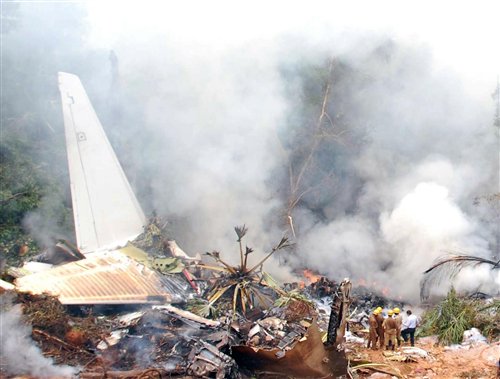
Mangalore, May 22: Tuesday marks a somber anniversary especially for Mangaloreans, who witnessed India’s third deadliest aviation disaster in its civil aviation history on May 22, 2010.
It was on this day two years ago that Air India Express flight IX812 from Dubai to Mangalore overshot the runway on landing, fell over the cliff, caught fire and scattered wreckage across the surrounding hillside at Kenjar near here. In all, 158 persons lost their lives, while eight survived this incident miraculously.
Two years down the line, there is a steady stream of visitors to ground zero, where the Boeing 737-8NG split into two and ended up in a ball of inferno, charring 152 passengers and six crew members on board.
People throng the site for various reasons. While for the next of kin of victims, a trip to ground zero is to establish an emotional connection, for the others it is just a matter of satiating their curiosity of having seen the crash site for themselves.
The memories of the mishap continued to lurk the lives of the kin of the victims, who even after two years, decided to continue their fight for ‘just and equal compensation’ that Air India should give for the death of their beloved ones.
Fight for Compensation
Though, during the first condolence meet held in the city, both the Air India authorities as well as the Civil Aviation top brasses had promised to settle the compensations within three months, the compensation dispensation procedure took the Counsel of the Air India about two years to complete.
The sole question that most of the family members of the victims ask is that whether the hearing really required this span of time or could it have been a bit faster.
Most of the kin of the deceased say that the handling of the claims by the Attorney has been haphazard, in the sense that they were randomly called for hearing.
“There was no fixed date for the hearing. Sometimes the Counsel sat once in four months. The families were called randomly without any chronological order of receipt of claim applications,” said a family member adding that if the Counsel wanted it could have settled the cases way before the expiry of ‘Law of Limitation’, which makes it mandatory to settle all the cases before two years of the date of the mishap.
Claims of Nanavati
However, contrary to the claims of victims’ kin, the Counsel for Air India Mulla and Mulla has claimed to have settled 159 cases of the 160 cases of passengers for Rs 115 crore.
Advocate and solicitor Hoshang D Nanavati from Mulla & Mulla told media that all cases barring one with a foreign firm had been settled either on full and final basis or as per the judgment of the Kerala high court.
"All claims for more compensation than the settled amount by the victims' families will be time-barred as per the Montreal Convention, which has set a two year period for appeals, if they have not filed a suit yet," he said.
Mahammed Beary, president of Mangalore Air Crash Victims' Families Association, said that about eight to 10 families of the crash victims, who were paid a compensation as per the Kerala HC's verdict might approach the civil court for more compensation or a minimum of one lakh SDR (Special Drawing Rights -roughly Rs 75 lakh.)
In January this year, the Supreme Court issued a notice to the Central government and AI on a petition by S Abdul Salaam seeking a minimum compensation of one lakh SDR under the Montreal convention each for the kin of all 158 persons killed in the crash. The matter will come up for hearing in October this year. Salaam, father of Mohammed Rafi, 24, who perished in the crash, approached the apex court after a division bench of Kerala high court in August, 2011 allowed AI's appeal and quashed an order by the single bench holding a minimum of one lakh SDRs to be payable in respect of death of each passenger.
Memorial
Mr Beary said, the office-bearers of Association are holding a meet to discuss over various issues pertaining to them during the second anniversary of the tragedy.
Since most of the families will be holding various religious programmes commemorating the demise of their beloved ones, only the office-bearers will meet and discuss mainly over the need to install a memorial at the mishap spot.
“A memorial was installed after the mishap but some miscreants had shown disrespect to the deceased members by destroying the memorial. We want to have something concrete this time. Air India had said that it would provide funds to Malavoor GP to have a building and promptly renowned Cardiologist Dr B M Hegde had said that memorial building should be named ‘Souhardha Bhavan’. We will look at materializing this,” said Mr Beary.
Unidentified Bodies
Lamenting over the present plight of the ground at Tannirbavi where 12 unidentified dead bodies were buried, Beary said that today trucks, lorries and heavy vehicles laden with sand and other commodities pass over the land.
“This is disrespect to the dead. We want the district administration to at least fence this area and maintain the sanctity of the place,” said Beary adding that in this regard a memorandum will be submitted to the Deputy Commissioner and the Air India authorities.
Also Read:







Comments
Add new comment